
USS Phoenix, a 9575-ton Brooklyn class light cruiser, was built at Camden, New Jersey. After commissioning in October 1938, she cruised along the Atlantic coast of South America on her shakedown, and in 1939 transferred to the Pacific, where she operated during the greatest part of her career. Based at Pearl Harbor in 1941, as relations with Japan deteriorated, Phoenix was moored there when the Japanese attacked on 7 December. She was among the ships that left the harbor during or shortly after the attack to undertake a search for the enemy task force. The cruiser spent the Pacific War's first month on convoy duty between Hawaii and the west coast, then steamed to Australia, her base in 1942 and much of 1943. During this time Phoenix covered the painful Allied retreat through the East Indies, protected shipping in the Indian Ocean and south Pacific, and operated with a force of U.S. and Australian warships in the New Guinea area.
In mid-1943, Phoenix went to the U.S. east coast for overhaul, but returned to the south Pacific to participate in the December 1943 landings at Cape Gloucester, on New Britain. For the rest of World War II she served with the Seventh Fleet, taking part during March-September 1944 in operations to seize the Admiralty Islands, the northern and western coasts of New Guinea and the island of Morotai. In addition to regular employment screening convoys and invasion task forces, and bombarding the enemy ashore, on 8-9 June she helped to pursue a group of Japanese destroyers that had attempted to bring reinforcements to the embattled island of Biak.
Phoenix next took part in the invasion of Leyte, in October 1944. As part of the Close Covering Group, she used her guns to soften up defenses ashore and, during the Battle of Surigao Strait on the night of 24-25 October, helped to decisively defeat a Japanese Navy counterattack. She continued to operate in the Philippines for several more months, fighting off suicide planes and shelling targets in support of assaults on Mindoro in December, into Lingayen Gulf in January 1945, Manila Bay in February and in the southern islands. In May-July, Phoenix covered a series of landings on Borneo.
The Pacific War ended in August 1945, as Phoenix was en route back to the United States for overhaul. She arrived in the Atlantic in September and was placed in reserve at the Philadelphia Navy Yard early in 1946. Formally decommissioned in July of that year, Phoenix remained in "mothballs" until early 1951, when work began to prepare her for duty with the Argentine Navy. Recommissioned in October 1951 with the new name 17 de Octubre, and General Belgrano after 1956, she served Argentina for more than three decades. On 2 May 1982, while steaming at sea during the war with Great Britain over the Falkland Islands, General Belgrano was torpedoed and sunk by the Royal Navy nuclear-powered submarine Conqueror.
This page features all the views we have related to USS Phoenix (CL-46).
| If you want higher resolution reproductions than the digital images presented here, see: "How to Obtain Photographic Reproductions." |
Click on the small photograph to prompt a larger view of the same image.
|
Photo #: NH 68326 USS Phoenix (CL-46) Photographed while at anchor, 1939. Courtesy of Donald M. McPherson, 1969. U.S. Naval Historical Center Photograph. Online Image: 85KB; 740 x 465 pixels |
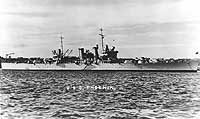 |
|
Photo #: NH 50766 Pearl Harbor Raid, December 1941 USS Phoenix (CL-46) steams down the channel off Ford Island's "Battleship Row", past the sunken and burning USS West Virginia (BB-48), at left, and USS Arizona (BB-39), at right, 7 December 1941. U.S. Naval Historical Center Photograph. Online Image: 87KB; 740 x 610 pixels |
 |
|
Photo #: 80-G-57445 Cape Gloucester Invasion, December 1943 USS Phoenix (CL-46) firing her 6"/47 guns during the pre-invasion bombardment of Cape Gloucester, New Britain, circa 24-26 December 1943. Photographed from the ship's fantail, looking forward. Official U.S. Navy Photograph, now in the collections of the National Archives. Online Image: 61KB; 740 x 600 pixels Reproductions of this image may also be available through the National Archives photographic reproduction system. |
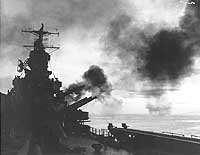 |
|
Photo #: SC 188839 Admiralties Invasion, 1944 Vice Admiral Thomas C. Kinkaid (left center) with General Douglas MacArthur (center) on the flag bridge of USS Phoenix (CL-46) during the pre-invasion bombardment of Los Negros Island, at the east end of Manus Island, 28 February 1944. At right is Colonel Lloyd Labrbas, acting aide to General MacArthur. Note 40mm quad gun mount in the background. Photograph from the Army Signal Corps Collection in the U.S. National Archives. Online Image: 96KB; 740 x 610 pixels Reproductions of this image may also be available through the National Archives photographic reproduction system. |
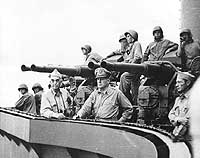 |
|
Photo #: SC 264436 Hollandia Operation, April 1944 LVTs head for the invasion beaches at Humboldt Bay, New Guinea, as cruisers bombard in the background, 22 April 1944. The ship firing tracer shells in the right center is USS Boise (CL-47). Just ahead of her is USS Phoenix (CL-46). Photographed by Tech4 Henry C. Manger. Photograph from the Army Signal Corps Collection in the U.S. National Archives. Online Image: 47KB; 740 x 605 pixels Reproductions of this image may also be available through the National Archives photographic reproduction system. |
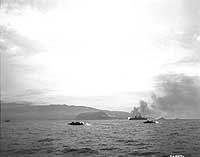 |
|
Photo #: 80-G-291377 Leyte Operation, October 1944 The Australian heavy cruisers Shropshire (left) and Australia (right), with a U.S. heavy cruiser, photographed through a ring gun sight on board USS Phoenix (CL-46), off Leyte on 21 October 1944. Official U.S. Navy Photograph, now in the collections of the National Archives. Online Image: 74KB; 740 x 605 pixels Reproductions of this image may also be available through the National Archives photographic reproduction system. |
 |
|
Photo #: 80-G-309448 USS Phoenix (CL-46) (right) Screening escort carriers (CVE) off Leyte, 30 October 1944. Photographed from one of the CVEs. Note flight deck barriers rigged in the foreground. Official U.S. Navy Photograph, now in the collections of the National Archives. Online Image: 76KB; 740 x 615 pixels Reproductions of this image may also be available through the National Archives photographic reproduction system. |
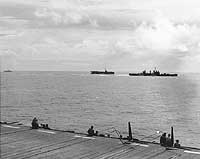 |
|
Photo #: 80-G-47471 USS Phoenix (CL-46) Crewmen at port side midships 5"/25, 20mm and 40mm anti-aircraft guns strain to identify a plane flying overhead, during the Mindoro invasion, 18 December 1944. This was a time of intense Kamikaze attacks, as the expressions on men's faces indicate. Note whaleboat in the lower left, anti-flash clothing, and floater net enclosed in a bag at right. Official U.S. Navy Photograph, now in the collections of the National Archives. Online Image: 121KB; 740 x 625 pixels Reproductions of this image may also be available through the National Archives photographic reproduction system. |
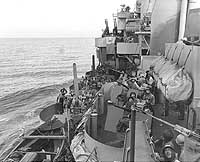 |
|
Photo #: 80-G-305461 Corregidor Operation, February 1945 Column of five light cruisers leaving Subic Bay en route to bombard Corregidor, 13 February 1945. Photographed from USS Phoenix (CL-46), which is followed by (from left to right): USS Boise (CL-47); USS Denver (CL-58); USS Cleveland (CL-55); and USS Montpelier (CL-57). Note signalman in the foreground, working with a blinker lamp. Official U.S. Navy Photograph, now in the collections of the National Archives. Online Image: 86KB; 740 x 610 pixels Reproductions of this image may also be available through the National Archives photographic reproduction system. |
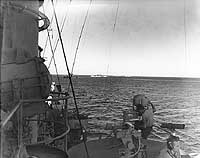 |
|
Photo #: 80-G-273279 Rear Admiral Russell S. Berkey, USN Speaks to another ship via electric megaphone (or "loud hailer") from the bridge of his flagship, USS Phoenix (CL-46), during the pre-landing bombardment of Corregidor, 15 February 1945. The original caption identifies the ship being spoken to as HMAS Australia, which was not present. It may refer to HMAS Shropshire, whose appearance was similar to that of Australia. Official U.S. Navy Photograph, now in the collections of the National Archives. Online Image: 95KB; 595 x 765 pixels Reproductions of this image may also be available through the National Archives photographic reproduction system. |
 |
Note: Another view related to USS Phoenix is:
In addition to the images presented above, the National Archives appears to hold other views of USS Phoenix (CL-46). The following list features some of these images:
The images listed below are NOT in
the Naval Historical Center's collections.
DO NOT try to obtain them using the procedures described in our
page "How to Obtain Photographic Reproductions".
|
Port broadside surface view of USS Phoenix (CL-46) in harbor, probably when she was first completed, circa October 1938. Starboard broadside surface view (somewhat toward the bow) of USS Phoenix (CL-46) in harbor, circa 1939. Starboard bow surface view of USS Phoenix (CL-46) in harbor, circa 1939. Port bow aerial view of USS Phoenix (CL-46) underway off the U.S. east coast, 20 September 1943. This is a rather grey and grainy view of the ship in pattern camouflage. It was taken from a Naval Air Station Weeksville, North Carolina aircraft Reproductions of these images should be available through the National Archives photographic reproduction system for pictures not held by the Naval Historical Center. The images listed in this box are NOT in the Naval Historical Center's collections. DO NOT try to obtain them using the procedures described in our page "How to Obtain Photographic Reproductions". |
| If you want higher resolution reproductions than the digital images presented here, see: "How to Obtain Photographic Reproductions." |
Page made 21 May 2002